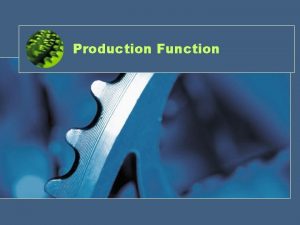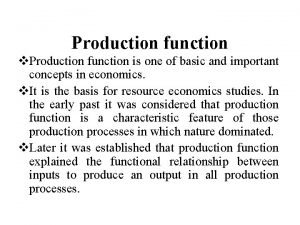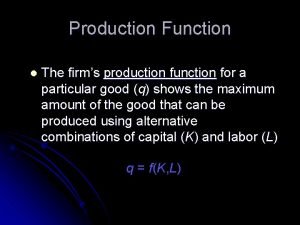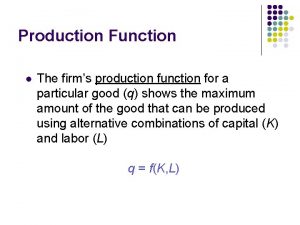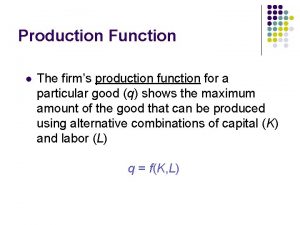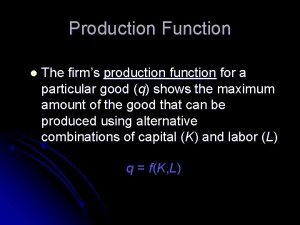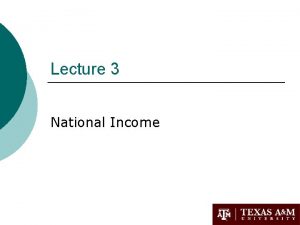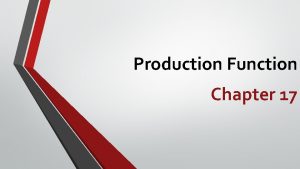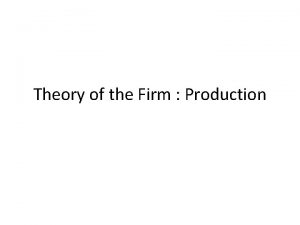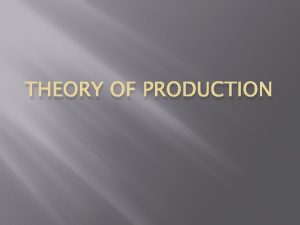Chapter 5 Production Theory The Production Function Production














- Slides: 14

Chapter 5 Production Theory

The Production Function • Production refers to the transformation of inputs into outputs (or products). • An input is a resource that a firm uses n its production process for the purpose of creating a good or service.

Production Function • A production function indicates the highest output (Q) that a firm can produce for every specified combinations of inputs (physical relationship between inputs and output) while holding technology constant • Mathematically, we represent a firm’s production function as: Q= f (L, K) • Assuming that the firm produces only one type of output with two inputs, labor (L) and capital (K).

Production Function • Q= f (L, K) • The quantity of output is a function of the quantity of labor (L) and capital (K) used production. • Output refers to the number of units of the commodity produced. • Labor refers to the number of workers employed. • Capital refers to the amount of equipment used in production.

Production Function in the Short Run • The short run is a time period in which the quantity of some inputs, called fixed factors, cannot be increased. • A fixed factor is usually an element of capital such as plant or equipment. Therefore, in our production function, capital is taken to be the fixed factor and labor the variable one • _ • Q = f (L, K)


Total, Average, and Marginal Products • Total Product (TP) is the total amount that is produced during a given period of time. – Total product will change as more or less of the variable factor is used in conjunction with the given amount of fixed factor. • Average Product (AP) is the total product (or output) divided by the number of units of the variable factor used to produce it. • Average Product of Labor: AP = TP / L • Marginal Product (MP) is the change in total product resulting from the use of one additional unit of the variable factor. • Marginal Product of Labor: MP = delta of Q /delta of L

Output with Fixed Capital and Variable Labor Quantity of Labor (L) Total Product (TP) 0 0 1 50 2 110 3 390 4 520 5 580 6 630 7 650 8 650 9 640 Marginal Product (MP) Average Product (AP)

Output with Fixed Capital and Variable Labor Quantity of Labor (L) Total Product (TP) Marginal Product (MP) Average Product (AP) 0 0 - - 1 50 50 50 2 110 60 55 3 390 280 130 4 520 130 5 580 60 116 6 630 50 105 7 650 20 93 8 650 0 81 9 640 -10 71

Example 1

Example 1

Production Function in the Long Run • A period of time in which all factors of production and costs are variable. • In the long run, firms are able to adjust all costs, whereas in the short run firms are only able to influence prices through adjustments made to production levels. • Total Cost = (Rate of Capital * Amount of Capital) + (Wage Rate * Quantity of Labor) • C = r. K + w. L • K= (C/r) – (w. L/r) (K being the Y-axis and L the X-axis) • The slope of the long term product curve is: (–w/r)

Long Term Production curve

Change in Capital vs. Change in Labor
 Production pre production post production
Production pre production post production Hát kết hợp bộ gõ cơ thể
Hát kết hợp bộ gõ cơ thể Lp html
Lp html Bổ thể
Bổ thể Tỉ lệ cơ thể trẻ em
Tỉ lệ cơ thể trẻ em Chó sói
Chó sói Thang điểm glasgow
Thang điểm glasgow Hát lên người ơi alleluia
Hát lên người ơi alleluia Môn thể thao bắt đầu bằng từ chạy
Môn thể thao bắt đầu bằng từ chạy Thế nào là hệ số cao nhất
Thế nào là hệ số cao nhất Các châu lục và đại dương trên thế giới
Các châu lục và đại dương trên thế giới Công của trọng lực
Công của trọng lực Trời xanh đây là của chúng ta thể thơ
Trời xanh đây là của chúng ta thể thơ Cách giải mật thư tọa độ
Cách giải mật thư tọa độ Làm thế nào để 102-1=99
Làm thế nào để 102-1=99















